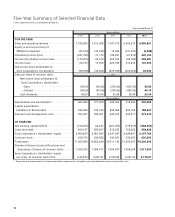Sony 2013 Annual Report Download - page 51
Download and view the complete annual report
Please find page 51 of the 2013 Sony annual report below. You can navigate through the pages in the report by either clicking on the pages listed below, or by using the keyword search tool below to find specific information within the annual report.
Environmental Activities Focusing on the Product Life Cycle
Research and Development
Focusing on electrical outlets, a crucial component of the
infrastructure through which electricity is supplied and con-
sumed, Sony is promoting the development of “authentica-
tion outlets” that make use of its contactless IC card
technology. When the device is plugged in, the outlet
“authenticates” the device and its owner and transmits the
correct amount of electricity.
In addition to facilitating the
calculation of per-user elec-
tricity consumption and moni-
toring the electricity use of
individual devices, these out-
lets are expected to find new
applications in the construc-
tion of new electricity services,
among other areas.
Product Planning and Design
In February 2011, Sony developed SoRPlas (Sony Recycled
Plastic), a flame-retardant plastic which uses more than
99% recycled materials, giving it the highest recycled mate-
rials rate among plastics in the world.* SoRPlas is made from
the recycled polycarbonate waste plastic collected from
within and outside the Sony Group and blended with a new
flame retardant containing sulfur, which Sony developed
internally. Sony expects SoRPlas to achieve an estimated
80% reduction in CO2 emissions in the plastic manufacturing
process (including transportation) compared with conven-
tional plastic. Beginning with three models of BRAVIA™ LCD
televisions launched in spring 2011, Sony has expanded the
product categories using SoRPlas. In fiscal year 2012, prod-
ucts featuring SoRPlas included digital recording binoculars
and Cyber-shot™ compact digital cameras.
Procurement*1
With regard to Sony’s designated chemical substances
contained in products and parts, Sony has formulated its
own set of standards for managing chemical substances,
which reflect global legal mandates such as EU REACH*2
regulations and the RoHS Directive*3 and the views of its
stakeholders. Sony also operates its own Green Partner
Environmental Quality Approval Program and other sys-
tems that reinforce its ability to ensure the appropriate
management of chemical substances in use. Moreover,
Sony keeps a close watch on environmental impact
throughout its value chain, including the monitoring of the
performance of its principal manufacturing outsourcing
partners. In fiscal year 2012, this enabled Sony to estimate
greenhouse gas emissions for its entire electronics-related
value chain as well as portions of its entertainment-related
value chain.*4
Operations
Sony sets a variety of environmental targets including
absolute targets on greenhouse gas emissions and waste
reduction on a unified global basis and takes a proactive
approach to reducing the environmental footprint of its
factories and offices worldwide. It also pursues activities
that suit the environmental needs of the surrounding local
community.
In fiscal year 2011, Sony began implementing the Green
Star Program, its own environmental performance assess-
ment program. This program provides a comprehensive
evaluation of the environmental initiatives of each Sony
Group site based on common standards, with a view
toward helping to improve the effectiveness of such
undertakings.
Logistics
Sony is decreasing gross transportation weight by reduc-
ing the weight of finished products. At the same time,
Sony is striving to reduce the volume of packaging materials
and CO2 emissions resulting from its logistics operations
by optimizing transportation eciency (i.e., size reduction
and modularization of product packaging to optimize load
eciency) and shifting to alternative modes of transporta-
tion that create less environmental impact.
Take-back and Recycling
Sony recognizes its social responsibility as a manufacturer
and adheres to the recycling laws and regulations of the
countries and regions in which it operates by promoting
the take-back and recycling of end-of-life products. At the
same time, Sony also actively operates voluntary take-
back initiatives, even in regions and countries—such as
some countries in South America—that have not yet intro-
duced recycling laws or regulations.
*1 Please refer to pages 44–45 for more details.
*2 REACH (Registration, Evaluation, Authorisation and Restriction of
Chemicals): Regulations introduced in the EU for managing chemical
substances
*3 RoHS: Directive on the restriction of the use of certain hazardous
substances in electrical and electronic equipment
*4 The Greenhouse Gas Protocol’s Scope 3 Standard and guidelines issued
by Japan’s Ministry of the Environment were referred in the calculation.
* Based on Sony research as of February 2011. Conventional flame retardant
recycled plastics used in electronics products have a recycled content
ratio of less than 60%.
49
Authenticationoutlet
























